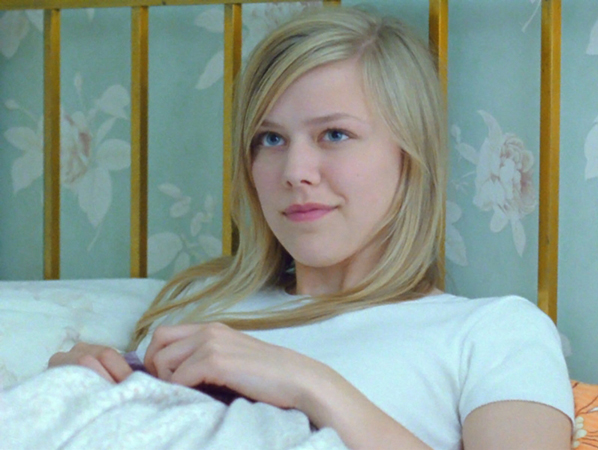A Flower Waiting To Bloom, by Patrick Felton
Few things are more refreshing than seeing the words “New Yorker Films” flash across the screen. Only 3 years after the film company shut down due to funding crises, the film world rejoices to see the legendary distributor of the world’s best art films back with new product. Its hard to imagine that Aladdin Distribution LLC, the new owners of the New Yorker Films library and moniker, ever imagined that their name flashed up on the screen followed by an opening scene where a Norwegian teenager masturbates on the kitchen floor while engaging in phone sex.
Yet, in watching Turn Me On, Dammit, the narrative debut of Norwegian documentarian Jannicke Systad Jacobsen, this act seems equal parts subversive and equalizing.
In the era of modern sex comedies, the subject of the sexual appetite of the adolescent male has been dealt with in great detail. So common that the id of the teenage boy been the subject of comedies that many view its fulfillment as a birth right.
Perhaps this is why, in its own way, Turn Me On, Dammit acts as a article of fourth-wave feminism.
In her protagonist Alma, (played beautifully by Helene Bergsholm) Jacobsen has given us an analogue to the self-important, male-dominated portrayal of teen boy’s sexual appetite that so permeate cinema. In the form of this Norwegian teenage nymphoid.
From the opening sequence of the film, Jacobson pulls no punches. We see a montage of the Norwegian countryside followed by a scene of a 16 year old girl pleasuring herself while talking to a phone sex operator on the kitchen floor. This is our introduction into the world of Alma, a sex-obsessed self-admitted horny teenager fixated on sexual pleasure.
The film continues to follow Alma as she drifts episodically in and out of sexual fantasy, seeks to fulfill her urges via phone sex, and obsessively pursues Stieg, the object of her affection, much to her own sabotage. (Think Belle De Jour meets Gilmore Girls, but in Norwegian.)
If possible, the film deals with the subject of teenage sex urges with grace, sweetness, and innocence. The film’s setting of the rural fjord country of Norway gives the film a bucolic flavor that creates the sense of restlessness only possible when you live in the middle of nowhere. Jannicke Systad Jacobsen’s filmmaking style is minimalist, utilizing handheld Super 16mm footage that never intrudes or overwhelms the strange drama that is manifesting itself on screen.
In this context, Alma’s shameless, super articulate, almost obsessive in her need to pleasure herself takes on a strange blend of quirky sweetness and embarrassing horror. Her need for sensual release is treated in a matter of fact way that neither endorses nor condemns her behavior. Its just a part of who Alma is.
Even more refreshingly, Alma is never reduced to the symbol of female oppression. While an early act in the first act of the film by a teenage boy is morally questionable, we never get the impression that Alma is submitting to some male fantasy or ideal of what female sexuality should look and feel like. In fact, the film reverses the traditional male gaze of nudity and sexuality with a series of fantasy sequences which occasionally objectify the males in ways similar to the way females are objectified in similar Western movies.
However, to portray Alma entirely as a rye analogue to the teen horndog trope is not entirely fair. The farther the film goes along, the stranger Alma gets. At no point is her behavior portrayed as normal or ideal. The films cast of teenagers spares no expense to ostracize her for her increasingly socially unacceptable sexual outburst. The key narrative thread of the film sees Alma’s classmates referring to her as “Dick Alma” after she makes a shocking assertion at a party. Her needs are humiliating, yet Alma remains unashamed despite the bullying, emotional pain, and heartbreak her urges cause.
Even in the deeply unpleasant consequences wrought upon Alma, the film never reduces these urges to pain. Her fixation is never blamed on childhood trauma, sexual abuse or any of the other tropes usually attributed to hypersexualized teenage characters in pop culture. For Alma, this is an obsession to fulfill something primal and deep inside of her to have something inside of her filled.
While seemingly revolutionary as a concept, the pursuit of teenage female pleasure doesn’t always translate to compelling storytelling. Alma is so deeply defined by this one characteristic that other aspects of her personality feel undeveloped. Perhaps this is masked in part by the pathos and startling beauty brought to the table by first time actress in the role of Alma. For the most part, it isn’t until the third act that the film addresses the emotional collateral created from the fallout of Alma’s actions. The film waits until the final sequences to show any semblance of emotional growth from Alma. The final two scenes of the film in particular blend the sweet with the deeply perverse. The final line of the film made me laugh out loud.
As both a feminist document and piece of entertainment, Turn Me On, Dammit remains imperfect.
However, it remains a refreshing alternative to the testosterone-laced fare that usually represents the teen years. In a year that has already bestowed upon audiences Project X, 21 Jump Street, and another American Pie movie New Yorker Films could do worse than this triumphant yet offbeat film which is sure to arouse much discussion.



























